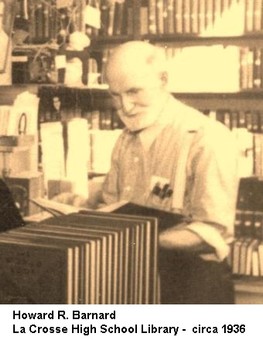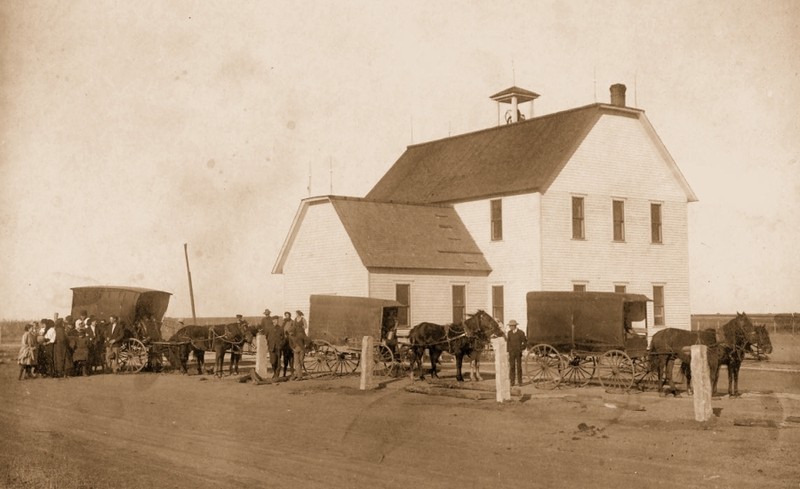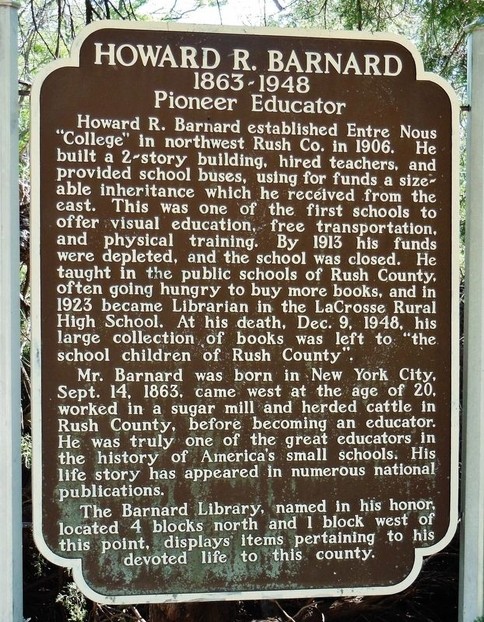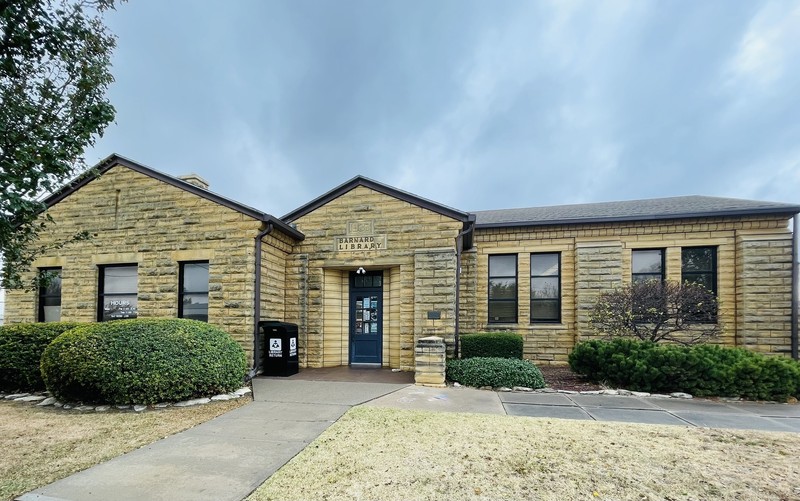Barnard Library
Introduction
Text-to-speech Audio
In 1906, one man sought to bring quality education to the women of the Kansas prairie. Howard Barnard, known as the pioneer educator, would eventually open the Enter Nous College eighteen miles outside of La Crosse. The modern college was one of the first to offer free transportation, visual education, and the first “bloomer girls” basketball team, and boasted a large library collection—many of the books which were from Barnard’s own collection. When the Entre Nous School was forced to close its doors due to lack of funding in 1913, Barnard continued to teach in public schools in Rush County and eventually became the librarian at the LaCrosse High School. The Barnard Library is named in his honor and displays items pertaining to his devoted life to teaching and service.
Images
Howard Barnard

Entre Nous College

Howard R. Barnard Marker

Barnard Library

Backstory and Context
Text-to-speech Audio
In 1906, one man sought to bring quality education to the women of the Kansas prairie. Howard Barnard came from a long lineage of educators. His great-uncle, Henry Barnard, along with Horace Mann started the Common School Movement of 1820-1860 to bring uniformity to all schools across the country. And perhaps more well-known, his cousin Frederick Barnard became the president of Columbia University and while there founded Barnard College for women. It was no shock then that Howard Barnard would also find himself dedicating his life to one of teaching and service.
After attending an exhibit at the Philadelphia Centennial Exposition in 1876, the young Howard Barnard was convinced to move to Kansas against his family's wishes. There he made his way across Kansas eventually landing in Rush Center where he performed odd jobs until he was able to pass the county teachers’ exam and began to teach in the McCracken area.
After fifteen years of teaching, in 1906, Barnard received $16,000 from his father’s estate and he put all of it into make his dream for education on the prairie come true. He bought several acres of land eighteen miles outside of LaCrosse and four miles outside of McCracken. There he built the Entre Nous (among us) College. The school was made up a of a large, two-story white frame structure that contained an auditorium, central heating plant, grand piano, and a telephone!
The first year only one pupil attended, but the following year ten high school students and sixty grade school students attended transforming Entre Nous into a social center on the plains. The modern college was one of the first to offer free transportation, visual education, the first “bloomer girls” basketball team, and boasted a large library collection—many of the books which were from Barnard’s own collection.
In 1906 the Entre Nous School was forced to close its doors due to a quarrel among the heirs to Mr. Barnard’s father’s estate which tied up the funds for the school. Lawyers promised a renewal of the income but that never happened. The courageous and generous teacher made every effort to keep the school but to no avail.
After Entre Nous closed Barnard again turned to teaching. With a passion for books, he began to accumulate a massive private library. Often, after completing the day teaching, Barnard would walk 25 miles north to Hays to buy books, returning the next morning in time to resume classes. Barnard was a rigid disciplinarian, but kind and considerate to his pupils. He had little patience with county superintendents who often did not have the same level of education as he did.
When superintendents tried to have him fired, mothers of the students intervened. In 1916, he was invited to move his collection of over 3000 books to the newly-constructed La Crosse High School. Later that year, the superintendent succeeded in firing him because his found his strict library rules to be overbearing. Learning about this and discovering that Barnard was destitute and sleeping in the railroad depot, several women in the La Crosse area banded together, formed the Barnard Library Association and raised money for his living expenses. They also got him reinstated as High School librarian paying his salary through the association. Within a year, he quit the High School and began teaching in rural schools in the area. At the 1923 annual meeting of the district, citizens demanded the school board rehire Barnard. He and his books remained there until 1937.
Cite This Entry
Kansas, Humanities. "Barnard Library." Clio: Your Guide to History. March 19, 2023. Accessed February 15, 2025. https://theclio.com/tour/2386/59
Sources
http://www.rushcounty.org/SchoolMuseum/barnard.html
https://www.hmdb.org/m.asp?m=155986
Miller, Allan. Yankee on the Prairie: Howard R. Barnard of Kansas--Pioneer Educator. Sunflower University Press, 2000.
Rush County Historical Society
Rush County Historical Society
Photographed by Cosmos Mariner.

